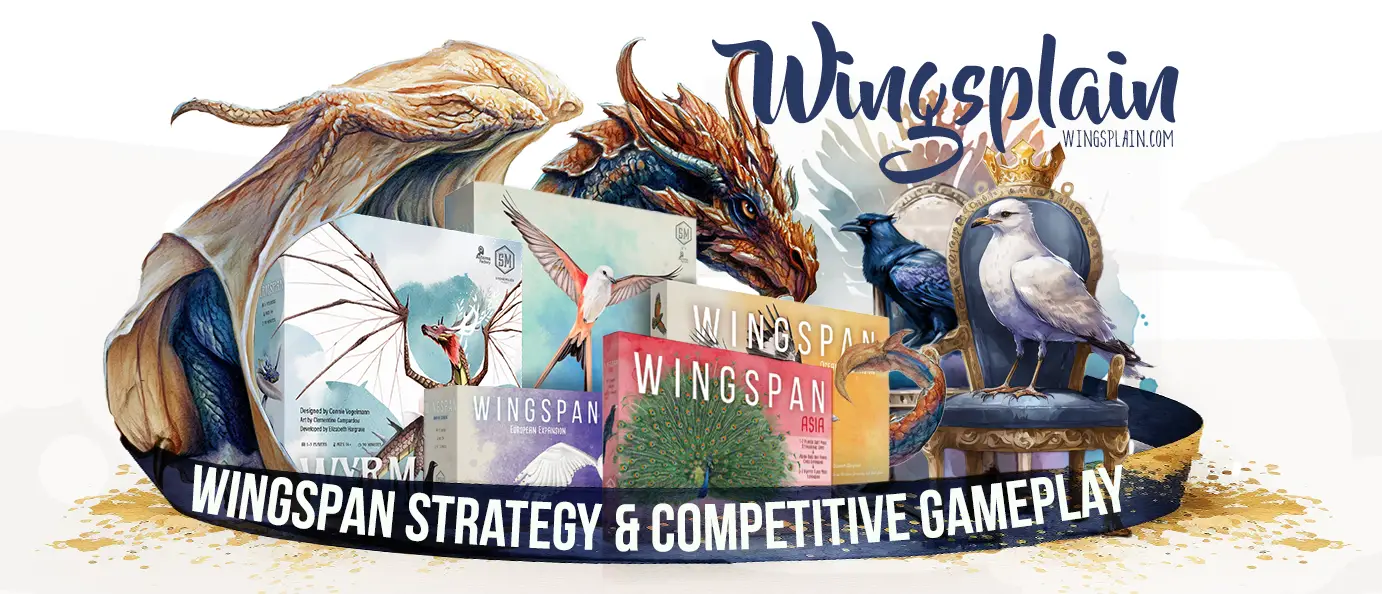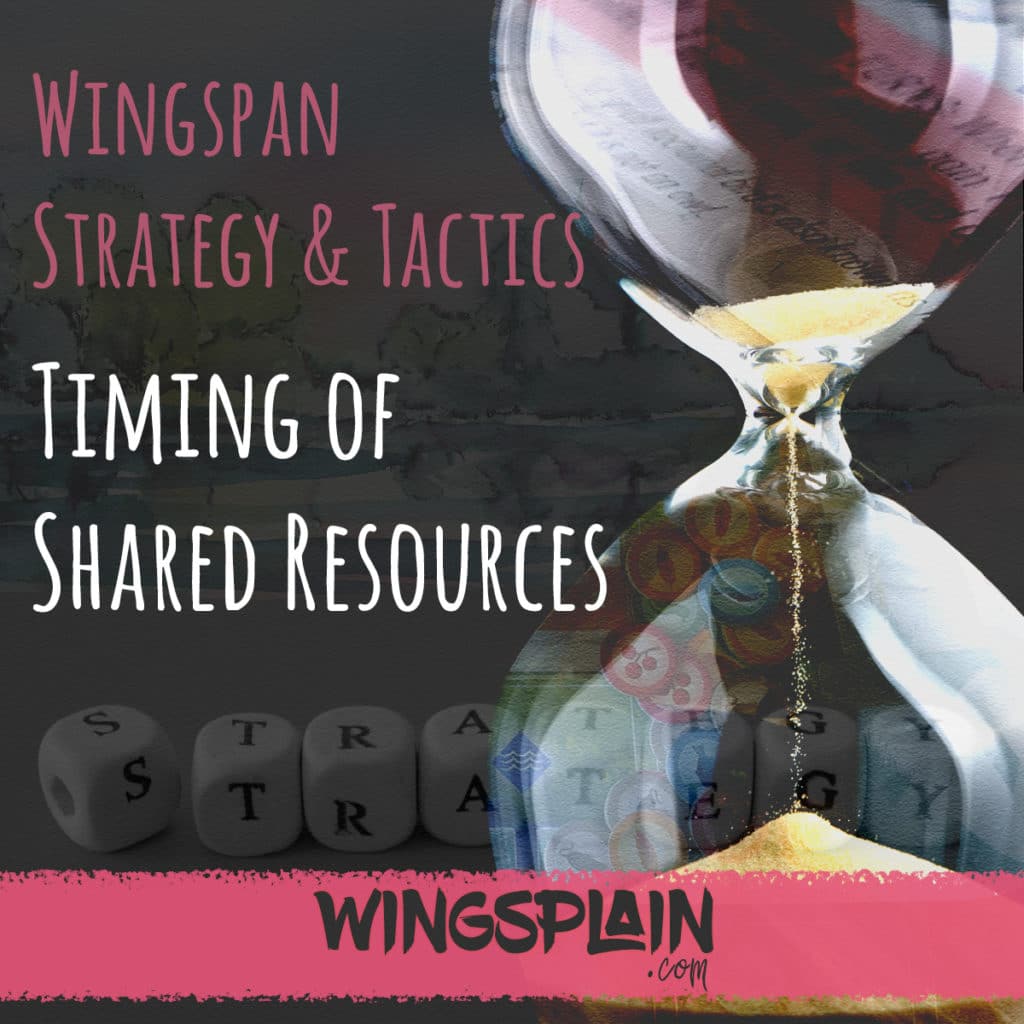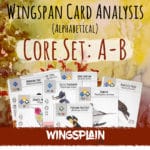Recently, a member of the official Wingspan Facebook group, Jacob Bruner, made an interesting request:
“I’d be interested to hear your take on the ‘When, why, and how’ of playing ‘friendly birds’ as I call them, or birds that benefit one or more other players. We often muse about ‘making sure it’s worth it’ to do so at the time of activations, and I’ll bet some newer Wingfriends would benefit from more case-specific discussion.”
It’s true that many of the more vocal members of the competitive community have stressed the importance of timing shared resources, but I don’t think I’ve seen any discussion where people really broke down the “When, Why, and How.”
I will attempt to do that here.
Philosophy of Wingspan
When playing Wingspan, we often have to take whatever options are presented to us at any given time. The card pool is large, and it will continue to get larger. We won’t have access to the best cards at all times.
In a perfect scenario, we would never give resources to our opponents. Still, sometimes that action represents our best option to acquire resources, or maybe it’s the balancing factor of a powerful card like Noisy Miner. In those instances, we need to think about optimizing the suboptimal.
This means that our best source of eggs might be a Pileated Woodpecker in the Forest, or our best source of food might be a Hummingbird in the Grasslands. Other benefits come with these examples, such as gaining food plus eggs from either the forest or the Grasslands, respectively.
Activating shared resource powers just because it’s the next bird in line is a lesson in defeat. A shared resource bird may be a critical part of your strategy, such as a Hummingbird in your Wetlands tucking engine, but you have to be tactical about its use. Is it close to the end of the game, and you’re not going to play any more birds? Skip the power. Is it the mid-game, and you drew something that would nicely build out your Wetlands engine? Then you should give that food out to all players because you need it to progress toward victory.
In this scenario, you’ve built food production into your tucking engine to help you ignore the Forest and maximize the effectiveness of your activations by aligning the acquisition of multiple resources and points from a single habitat (this is why The Power Four are so good). If you happen to have a couple of birds in your forest, especially if they produce food themselves, its best to spend one activation to gain a bunch of food at once at the expense of running your tucking engine (and I probably wouldn’t have played the Hummingbird to start with if I had this option early).
What this does is trade the several points you would have gained tucking for one turn of resource gathering. The best engines want to be activated repeatedly, but sometimes you need to take a break for food, eggs, or cards if you are missing that component of your game.
1. You can’t progress without the resource.
Examples:
You’re building heavily into the Forest, and you need eggs to play more birds. Activating your Pileated Woodpecker will give you two eggs for your next one to two bird placements. You’re gaining food and two eggs simultaneously, and you don’t want to spend a turn getting just two eggs from your empty Grasslands. The consequence is that two of your opponents have cavity nests, so they will each get an egg, but the trade-off is very worth it to you. You’re gaining two eggs plus food (and maybe more depending on your engine) to their one egg.
You’ve kept a Red-Winged Black Bird and Anna’s Hummingbird from your opening hand. You play the Blackbird on turn one. On turn two, you draw, tuck, and lay an egg. On turn three, you play the Hummingbird spending one wild food and the egg from the blackbird. You’ve now built an early game Wetlands engine that draws two cards, gains one food, lays one egg, and scores one victory point by tucking a low-impact card. You gain all of this at the cost of handing one food to all of your opponents. This is a pretty good trade-off. You are now in the position to continue to draw, generate food for your next bird, generate eggs for your next bird(s) and score victory points all from the same habitat and the same activation. It’s no longer worth it for you to go to the Forest or Grasslands for resources unless you deliberately build those out to be worth more. You may find it valuable to drop one to two food-producing birds in the forest eventually to give you a lot of food in one activation instead of relying on the single food from your Hummingbird each turn. This eliminates giving your opponents food help through the entire game.
2. You have a bird in line that checks your opponent’s resources and gives you something more based on what they have.
This net gain stacks on top of the shared resource for you.
For example, you activate a Hummingbird, and the opponent to your right happens to grab nectar from the bird feeder. Your next bird in line is Pesquet’s Parrot, which now lets you get a nectar from the general supply because your opponent now has one. You’ve gotten two food to your opponents’ one by activating a shared resource. You’ve successfully mitigated some of the consequences of giving something to your opponents. You’ve gotten more out of it than they have.
Another example is when you tuck a card under your Major Mitchell’s Cockatoo and it gives all players a seed. You have Eurasian Jay next in line that steals one seed from any opponent and caches it (they then get a die from the birdfeeder). You have now gained two net victory points and one seed from activating your shared resource bird while everyone else only gets one seed. Again, you’ve gotten more out of it than they have.
3. Your opening hand was garbage, and the bird tray isn’t helping.
You decide to keep the Spotted Sandpiper and American Oystercatcher in the attempt to dig for better cards. Eventually, you manage to get both cards on the board. The Oystercatcher gives you the first pick and the last pick. Your opponents’ get one card each. You’re going to get the best card and probably the worst card out of that draw. You continue to have bad luck, and you didn’t draw anything helpful. Next turn, you decide to activate your Wetlands. You draw two cards, and they are expensive three food birds. Now you’re feeling desperate. You need a good option right now, or you can kiss this game goodbye. You decide to activate the Sandpiper to hopefully draw into a miracle. Your horrible luck is pushing you to dig as deep as possible to find a solution to your problem, and giving a bunch of cards to your opponents is the cost for that search.
Summing It All Up
The key point is that you should try setting up scenarios in which you are gaining not just more, but a healthy amount more, from the activation of a shared resource bird than your opponents. If you just make small gains, it’s possible that your opponents can use your help to pull ahead of you in a big way that only a healthier engine or big point bomb of your own will counter.
On the other end of the spectrum, your position might be horrible, and you need any and all solutions to get you out of what would otherwise be a guaranteed lost game.
I believe this captures the essence of the philosophy of appropriately timing shared resources. Feel free to let me know what you think in the comments below.




I don’t usually ask myself “should I activate”, since the bird’s inclusion on my board means I’ve already factored its use in my strategy. So my main takeaway from this post is to consider when to skip these cards altogether. Very nice!
I really like that these friendly cards are in the game though. They’re a lot of fun when playing with my wife, kids, or just casual. They keep the game moving for all players, and even beginners might see some big scores as a result of needing to use less of their own activations. (We’re pretty new to the game. Played my friend’s physical game, and now loving the new iOS version — especially the pass and play on the family iPad, and asynchronous 3 player online auto-match games.)
Yeah, worrying about shared resources is only relevant if you’re being competitive. Some people like to play cooperatively and play for combined high scores. Wingspan really hits a sweet spot in a lot of ways as far as games go.
That’s brilliant. And doesn’t even require variant rules to play cooperatively, just a change in strategy. Maybe we’ll try that sometime.